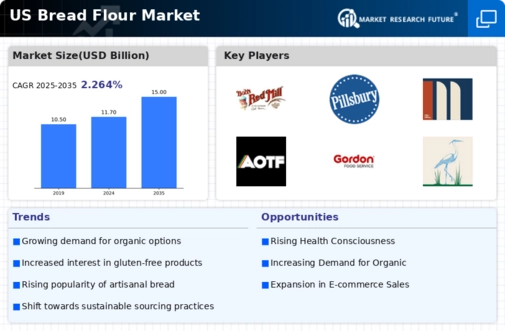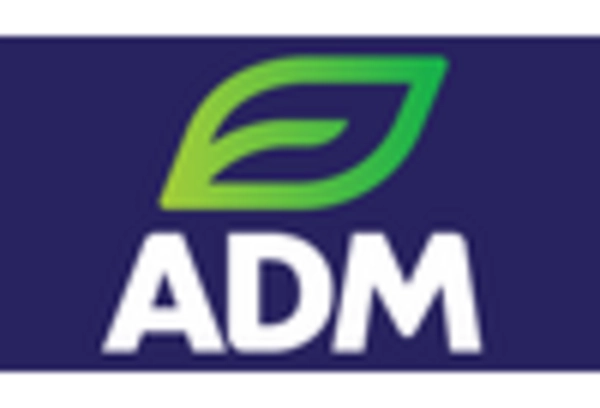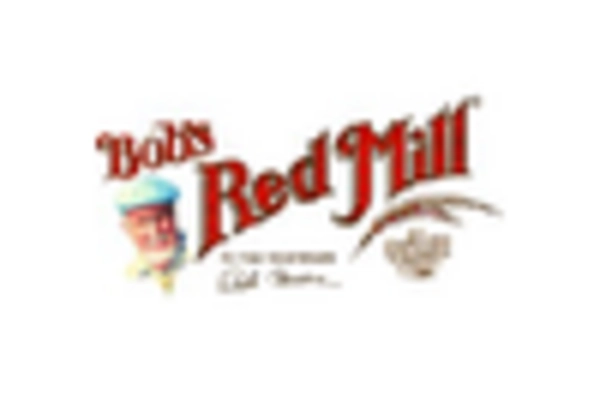Growth of the Home Baking Trend
The home baking trend has gained substantial traction, particularly in recent years, influencing the bread flour market significantly. As more individuals engage in baking as a hobby, the demand for high-quality bread flour has increased. This trend is supported by data indicating that retail sales of flour have risen by approximately 15% in the past year alone. The bread flour market is witnessing a surge in demand for specialty flours, including organic and artisan varieties, as home bakers seek to replicate professional-quality results. Furthermore, the proliferation of online baking tutorials and social media platforms has inspired many to experiment with different recipes, thereby increasing the consumption of bread flour. This trend appears to be sustainable, as the enjoyment of home baking continues to be a favored pastime for many.
Expansion of the Food Service Sector
The food service sector's expansion plays a crucial role in driving the bread flour market. With the rise of cafes, bakeries, and restaurants, there is a growing demand for high-quality bread flour to meet the needs of these establishments. The bread flour market is experiencing increased orders from food service providers, as they seek to offer a diverse range of baked goods to their customers. Recent statistics suggest that the food service industry in the US is projected to grow by 5% annually, further boosting the demand for bread flour. Additionally, the trend towards artisanal and gourmet offerings in restaurants is prompting chefs to seek premium flour options, thereby enhancing the market's growth potential. This dynamic interplay between food service expansion and flour demand indicates a robust future for the bread flour market.
Increased Focus on Gluten-Free Options
The rising demand for gluten-free products is a notable driver in the bread flour market. As awareness of gluten sensitivities and celiac disease grows, consumers are actively seeking gluten-free alternatives. This trend is reflected in the market, where gluten-free flour sales have seen a remarkable increase, accounting for approximately 10% of total flour sales in the US. The bread flour market is responding by expanding its product lines to include gluten-free flour options, catering to this niche yet growing segment. Additionally, the development of innovative gluten-free blends that mimic the texture and taste of traditional bread flour is becoming more prevalent. This focus on gluten-free offerings not only meets consumer demand but also presents opportunities for brands to differentiate themselves in a competitive market.
Rising Demand for Whole Grain Products
The increasing consumer preference for whole grain products is a notable driver in the bread flour market. As health awareness rises, many consumers are gravitating towards whole grain options, which are perceived as healthier alternatives. This trend is reflected in the market, where whole grain flour sales have surged, accounting for approximately 30% of total flour sales in the US. The bread flour market is adapting to this shift by offering a wider variety of whole grain flours, catering to the evolving tastes and nutritional preferences of consumers. Additionally, the incorporation of whole grains into various baked goods is becoming more prevalent, further driving demand. This shift not only influences product offerings but also impacts marketing strategies, as brands emphasize the health benefits associated with whole grain consumption.
Innovations in Packaging and Distribution
Innovations in packaging and distribution are emerging as significant drivers in the bread flour market. As consumer preferences evolve, the demand for convenient and sustainable packaging solutions is increasing. The bread flour market is responding by adopting eco-friendly packaging materials and innovative designs that enhance product freshness and shelf life. Moreover, advancements in distribution channels, including e-commerce platforms, are facilitating easier access to a variety of bread flour products. Recent data indicates that online sales of flour have increased by over 20% in the past year, reflecting a shift in consumer purchasing behavior. This trend suggests that companies that invest in innovative packaging and efficient distribution methods may gain a competitive edge in the market, appealing to environmentally conscious consumers and those seeking convenience.

















Leave a Comment